Reserve Bank of Australia Annual Report – 1991 Financial Markets and the Bank's Operations
For much of the past twelve months international financial markets were unsettled. Exchange rates and interest rates moved in wide bands in response to divergent monetary policies in the major countries, and events in the Middle East and Eastern Europe also left their mark. By comparison, markets in Australia were relatively settled and orderly.
Short-term interest rates in the United States fell over 1990/91 while they rose in Germany and Japan. The consequential change in interest rate differentials saw the US dollar decline sharply against the mark and the yen in the first half of the year but this was reversed in the second half when the US dollar benefitted from its “safe-haven” status at the time of the Gulf war and, subsequently, from signs that the US recession was nearing an end. The dollar's rise was particularly strong against the mark which continued to be affected by uncertainty associated with the problems of German unification. Overall, it ended the year 9 per cent higher against the mark and 10 per cent lower against the yen.
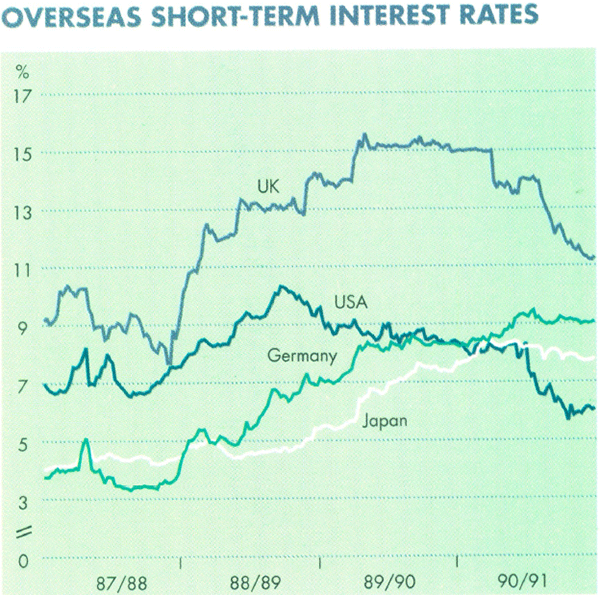
Bond yields in the major countries showed little net change over the year, although there were some big swings within the year. Yields rose strongly after the invasion of Kuwait but declined as Middle East tensions eased and the outlook for inflation improved. Share markets, like bond markets, weakened after the invasion. The fall was most pronounced in Japan where war-related uncertainties coincided with a squeeze on asset prices stemming from a tight monetary policy. Share markets in most countries recovered somewhat in the second half of the year.
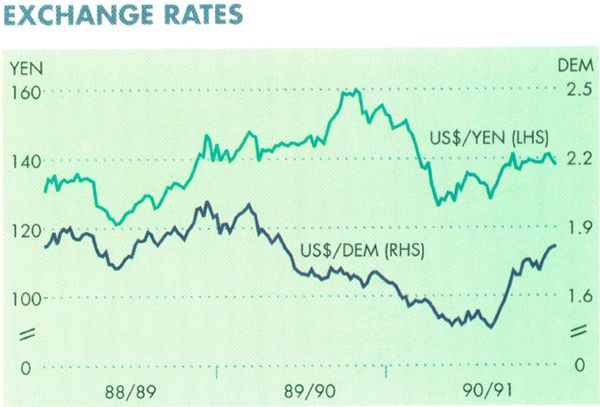
Australian financial markets were affected by these international events but other major influences were the progressive relaxation of domestic monetary policy and the improved outlook for inflation. Short and long-term interest rates both declined to their lowest levels for some years. With the former falling more sharply, the yield curve moved from being inverse at the start of the year to slightly upward sloping by the end.
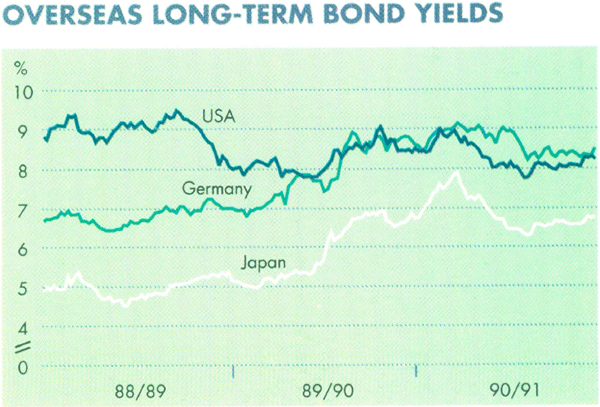
In the foreign exchange market, two key features were the strength of the Australian dollar and a reduction in its volatility. As noted earlier, the strength of the currency, despite the fall in domestic interest rates and in commodity prices, was somewhat surprising. It is, however, less surprising when account is taken of the ground gained against inflation, the relatively high interest differentials on offer and the economic and political uncertainties confronting many other countries during the year. The better inflationary outlook, in particular, did much to sustain investor confidence in Australia. It was also a contributing factor in reducing the volatility in the exchange rate; in the second half of 1990/91, volatility of the Australian dollar against the US dollar was less than half that of the major currencies.
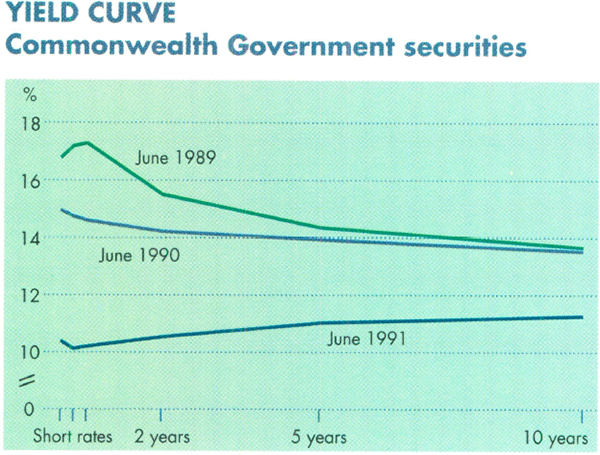
On occasions during the year, demand for the Australian dollar mounted to a point where the Bank judged it appropriate to intervene in the market to sell the currency. This intervention was most obvious in October 1990 when the Bank's sales of Australian dollars, combined with official comments, contributed to a fall in the exchange rate of 7 per cent in trade-weighted terms. A similar set of circumstances arose in May 1991 when the Australian dollar fell 3 per cent in trade-weighted terms. In large measure, these falls merely reversed earlier rises in the exchange rate. Overall, the Australian dollar ended the year only slightly lower than at the start, both in trade-weighted terms and against the US dollar.
The Bank's Operations
Domestic Markets
The Bank operates in domestic money and securities markets and in the foreign exchange market. In domestic markets, it buys and sells Commonwealth Government securities to affect the supply of liquid funds to the overnight money market and thereby influence the rate of interest at which the market clears. Changes in this overnight cash rate are the primary indicator of changes in monetary policy; they flow through quickly to other short-term interest rates and to rates charged by intermediaries.
Apart from implementing monetary policy changes, the Bank operates on an almost daily basis to offset the ebb and flow of cash in the money market. These fluctuations reflect a number of influences, including banks' purchases and sales of currency, the Bank's own foreign exchange transactions and, most importantly, the financial transactions of the Commonwealth Government. The Bank's domestic market operations are conducted in short-term Commonwealth Government securities and repurchase agreements with eight authorised money market dealers.
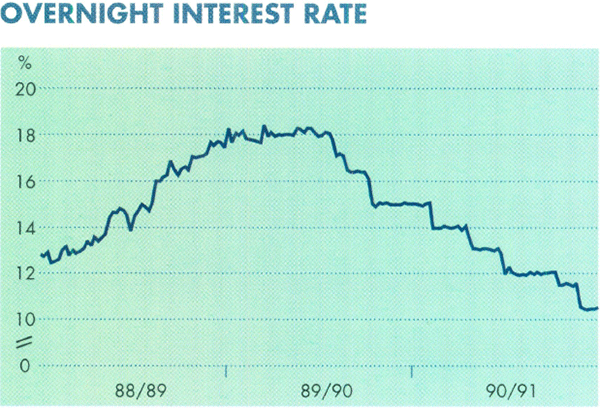
The Bank also trades in longer-term bonds with nineteen reporting bond dealers. While these transactions also influence the amount of funds in the money market, they are for relatively small volumes and are undertaken primarily to help maintain an active and efficient secondary market for bonds; this, in turn, assists the Commonwealth's management of its debt.
With monetary policy continuing to be implemented through discrete changes in cash rates, those rates have declined in a step-like fashion, with little movement between policy changes. Security yields, on the other hand, have tended to fluctuate more in line with shifts in market sentiment. For much of the year, yields on short-term securities such as Treasury notes and bank-accepted commercial bills were lower than cash rates, as market participants anticipated further policy easings. Over the year as a whole, however, the fall in short-term security yields was about the same as that for cash rates.
Yields on longer-term securities fluctuated in a fairly narrow band in the early months of 1990/91. They declined following the release in early November of the September quarter CPI indicating a sharp fall in inflation, and continued to decline over much of the rest of the year as expectations of lower inflation gained currency. With the release in mid May of the negative CPI result for the March quarter, yields on long bonds dipped a little below 10.5 per cent, their lowest level since 1980. Part of this fall was reversed towards the end of the year following forecasts of a sizeable Commonwealth Budget deficit in 1991/92 and some uncertainty surrounding the Ministerial changes. Over the year, however, there was a net decline of more than 2 percentage points, to about 11 per cent.
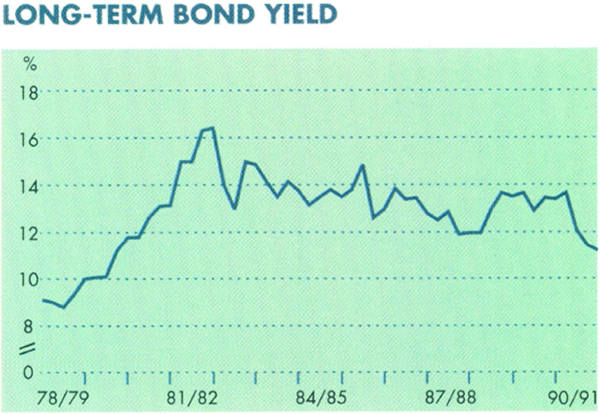
Intermediaries reduced their interest rates on both deposits and loans as market rates declined. Interest rates on term and large deposits at banks fell broadly in line with short-term market rates; rates on smaller “retail” deposits, which earlier had risen by less, also fell by less. The shift in deposit balances from zero-interest and low-interest accounts (cheque and passbook accounts) towards higher-interest accounts (fixed deposits and cash management accounts) continued; this trend was reinforced in a minor way by the introduction of “deemed” income rules for social security recipients; effective in March 1991, these rules encouraged recipients to seek an interest rate of at least 10 per cent (reduced to 8 per cent in June) on their deposits in lieu of the lower returns generally available on other retail deposits. Many intermediaries introduced new accounts for eligible pensioners which offered the deemed interest rate.
The fall in indicator lending rates for business loans over the year was similar to the fall in short-term interest rates. In June 1991, the major banks' benchmark rates ranged between 14 and 14.5 per cent; twelve months previously, the range was from 18 to 18.75 per cent.
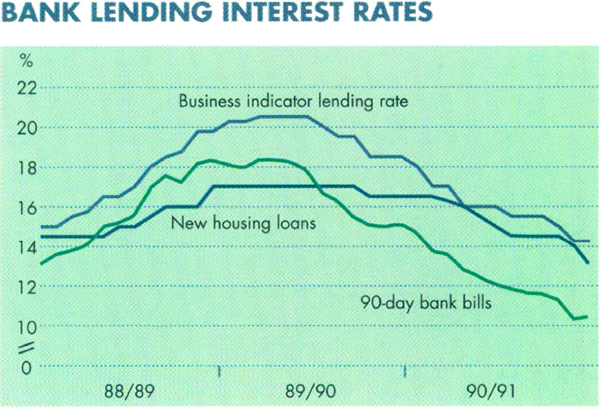
Bank interest rates on new housing loans to owner-occupiers were reduced by about 3.5 percentage points in 1990/91 and are now below the 13.5 per cent ceiling applicable to loans taken out before April 1986 (rates on these loans were reduced in line with rates on loans approved after April 1986). During the year, competition among lenders for housing business – a preferred form of lending in current circumstances – saw the introduction of special offers for new loans such as interest-caps for six to twelve months and fee waivers.
Bank Interest Rates
Banks' interest rates were the subject of close scrutiny during the year amid reports that banks had failed to pass on to borrowers the full extent of falls in official interest rates. Similar concerns have been evident in the United Kingdom, United States and some other countries.
The Bank has endeavoured to uncover the facts surrounding movements in the banks' interest margins. Some commentators based their conclusions on a simple comparison of banks' indicator lending rates and the overnight cash rate, the former being used as a measure of banks' interest rates on loans and the latter as a measure of banks' costs of funds. This “gap” widened from between 2 and 2.5 percentage points during 1989 to about 3.5 percentage points by mid 1990; the gap remained at 3.5 percentage points in mid 1991. This simple measure, however, suffers from too many deficiencies to be useful. It does not allow, for example, for lags between changes in interest rates quoted on new deposits and loans and average rates paid and received by banks on outstanding deposits and loans. When the general level of interest rates falls, rates on new term deposits fall but banks can go on paying higher rates on existing term deposits for some months.
Over the longer term, the effects of these lags on the measure are less important but other more serious deficiencies can arise. In particular:
- shifts in the proportions of low-interest and high-interest deposits can affect the cost of funds to banks even if cash rates remain unchanged. Over the past two years the average proportion of high-cost deposits – i.e. term and call deposits and deposits in cash management accounts – has increased from 43 per cent to 56 per cent for the major banks. Other things equal, including the overnight cash rate, this would have lifted banks' average cost of funds by about three quarters of a percentage point;
- although the banks' various loan indicator rates generally move together, significant differences can persist even over the longer term. When interest rates were rising, for example, the gap between housing and business benchmarks widened appreciably. In the downswing, however, the business indicator rates have tended to fall further than housing rates. No one rate necessarily tracks the overall earning rate on the loan portfolios.
A much better measure of banks' interest margins is provided by the difference, or “spread”, between average interest rates paid on domestic deposits and average interest rates received on domestic loans and interest-bearing investments. For the major banks, the average interest spread measured in this way was about 5 percentage points through the first half of the eighties and between 4½ and 5 percentage points in the second half. In the past two years, however, it is estimated to have declined to little more than 4 percentage points. This has reflected a number of influences, including the shift to higher-yielding deposit accounts, as well as the sharp increase in non-performing loans on which the banks do not earn a return.
On the basis of this measure, any actions on the part of banks in delaying reductions in loan interest rates, or in increasing the margins above indicator rates they charge different categories of customers, have only partly offset the influences working to squeeze banks' average interest spreads.
Banks and their customers have all been caught up in this adjustment process, in different ways. Those depositors who have switched from low-interest to high-interest deposits, for example, have benefitted. Some borrowers, on the other hand, have faced increases in the margins they pay over indicator lending rates (as the banks have reassessed the credit risks attached to different categories of borrowers) although the net effect of this necessary reassessment on banks' income appears to have been minimal. And, of course, bank shareholders have borne part of the burden through, for example, reductions in dividend payments and share prices. This too is appropriate, although there are limits to how far bank profitability can be squeezed while still maintaining a viable banking system which is equipped to meet the financing needs of a growing economy.
Foreign Exchange Market
In the foreign exchange market, the Bank's operations in 1990/91 were directed mainly at meeting the foreign currency needs of its clients, although on occasions they were aimed also at steadying market conditions.
As noted earlier, demand for the Australian dollar remained remarkably robust during 1990/91. In addition, volatility in the Australian dollar (measured as the average absolute daily percentage change in the exchange rate) declined sharply. The Australian dollar's exchange rate against the US dollar was much more stable than the exchange rates of the major currencies against the US dollar and, in the second half of the year, volatility declined to levels approaching the pre-float experience. Part of this lower volatility reflected the emergence of a more mature foreign exchange market with less speculative position-taking. More fundamentally, it reflected the market's reaction to the improvement in the inflation outlook, as well as concerns about developments in other countries.
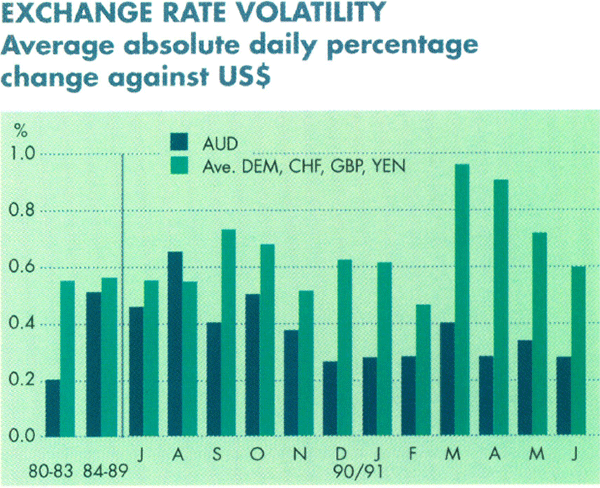
The greater stability in the exchange rate made for more subdued growth in market turnover than in earlier years. Average daily turnover in Australian dollars was $18 billion, up only marginally on the previous year after several years of strong growth. On the other hand, turnover in the Australian foreign exchange market involving third currencies (i.e. transactions other than in Australian dollars) continued to grow strongly, averaging $24 billion a day, up from $21 billion a day the previous year.
The Bank was a buyer of foreign currency in the market through much of 1990/91. This was mostly to meet the Commonwealth Government's requirements although in October and, to a lesser extent, in May, the Bank operated in the market to provide some resistance to the rise in the value of the Australian dollar. In early October the Australian dollar went over 83 US cents (almost 62 in trade-weighted terms), reflecting market perceptions of Australia as a “safe-haven” and an energy-rich country at the time of the Middle East conflict. A continuation of that trend would not have been helpful in pursuing the necessary medium-term correction of Australia's current account problem. Falling inflationary expectations and a continuing weak economy also meant that a modest depreciation could be accommodated without risk of serious adverse consequences. Following the easing in monetary policy on 15 October, therefore, the Bank undertook substantial sales of Australian dollars, totalling $1.3 billion over the month. These actions, combined with official comments sanctioning a lower exchange rate, saw the Australian dollar return to 77 US cents (56 on the trade-weighted index).
By mid May, the Australian dollar had regained about two-thirds of its October fall, in trade-weighted terms, despite the further relaxations of monetary policy in December and April. The Bank repeated its October approach, although with smaller sales of Australian dollars, and the exchange rate again reacted, falling to 76 US cents (58 on the trade-weighted index).
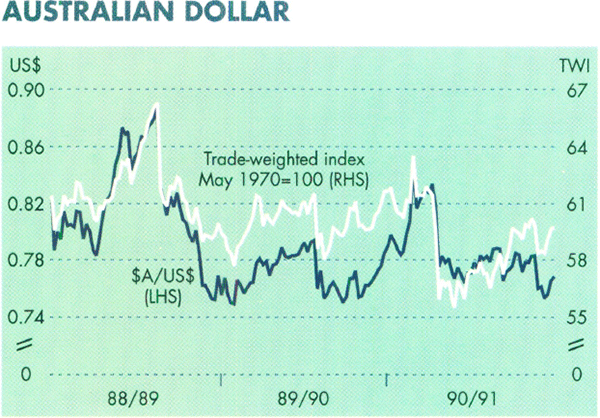
The rate steadied for a while around these levels but nervousness emerged at the time of Ministerial changes in early June. With market conditions threatening to become disorderly, the Bank intervened with a view to restoring stability and orderliness. In the event, the rate soon steadied around 75 to 76 US cents and ended the year at 76.8 US cents. This represented a net fall against the US dollar of about 3 per cent over the course of 1990/91; in trade-weighted terms, the rate was also down 3 per cent, at 59.7.
It is always difficult to judge the effects of central bank intervention in the market. The Bank recognises that with a deregulated market and floating exchange rate it is not possible in the long run for the authorities to maintain an exchange rate at other than its market-determined level. In the short run, however, experience both in Australia and overseas suggests that timely intervention and official comments can have an influence on the exchange rate, particularly through their impact on market sentiment. In its actions in the market during 1990/91 the Bank sought to exert a moderating and steadying influence – to cause the market to pause and reflect on the level of the exchange rate in relation to more fundamental influences. By and large this result was achieved.
The Bank's Portfolios
The Bank's transactions in the domestic securities and foreign exchange markets affect the composition of its balance sheet. Over 1990/91, the Bank's domestic operations involved purchases and sales of Commonwealth Government securities which were each in the region of $60 billion; its holdings rose by about $0.8 billion. In the foreign exchange market, the Bank's transactions resulted in net purchases of foreign currency amounting to the equivalent of $4.6 billion, which were matched by sales to the Commonwealth Government. Interest receipts and valuation effects, however, resulted in an overall rise of $2.2 billion in the Bank's holdings of gold and foreign exchange.
Securities Markets
Securities markets generally were subdued in 1990/91 with respect to both new issues and secondary market activity. One exception was the market for securities issued by State Government instrumentalities, where turnover continued to rise strongly as issuers sought to manage their debt actively and promote the liquidity of their stock.
Commonwealth Government Securities
The stock of Commonwealth Government securities on issue in the domestic market (excluding holdings by the Loan Consolidation and Investment Reserve) rose by $2.3 billion in 1990/91, the first increase since 1986/87.
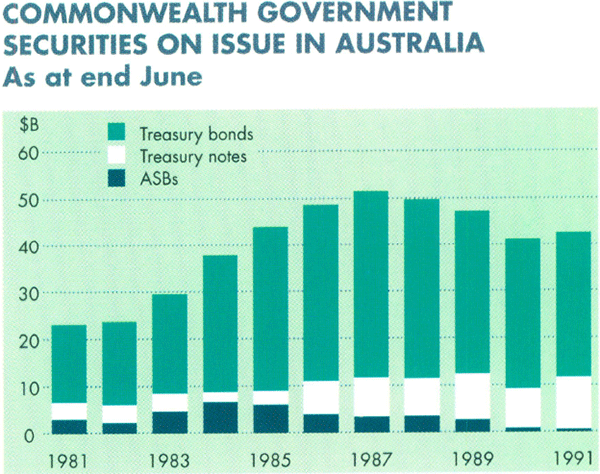
The stock of Treasury bonds fell by $1 billion, much less than was envisaged at the start of the year. The prospective surplus at that time was expected to be sufficient to accommodate maturing stock and substantial repurchases of Treasury bonds. As the projected surplus receded, however, the Government was obliged to raise additional funds from the market. Two tenders of Treasury bonds totalling $2 billion were held in the June quarter, the first since July 1989. The balance of the Government's financing needs was met by additional issues of Treasury notes; the stock of notes increased from $8.2 billion to $11.9 billion over the year. The volume of Australian Savings Bonds on issue fell further in 1990/91, to $0.5 billion; all outstanding ASBs will mature by 1994/95.
Some further restructuring of the stock of Treasury bonds on issue occurred in 1990/91. The Commonwealth repurchased stocks which the Reserve Bank had acquired through its regular operations with reporting bond dealers in exchange for more liquid lines from the Loan Fund and the Loan Consolidation and Investment Reserve. This helped to maintain a liquid market for bonds by replacing less popular securities with those more in demand. It also improved the marketability of the Bank's portfolio of bonds.
Under the changes agreed between the States and the Commonwealth at the 1990 Premiers' Conference, the States are now responsible for their own debt and will progressively replace maturing Commonwealth Government securities issued on their behalf with their own securities. In 1990/91, $1.1 billion of Commonwealth paper issued on behalf of the States was retired.
Secondary market trading of Commonwealth Government securities was fairly steady, albeit at levels lower than in the mid to late 1980s when the Commonwealth was making large primary issues. Turnover of Treasury bonds averaged around $1 billion a day in the June quarter 1991, the same as a year earlier. Turnover of Treasury notes declined moderately to about $700 million a day on average.
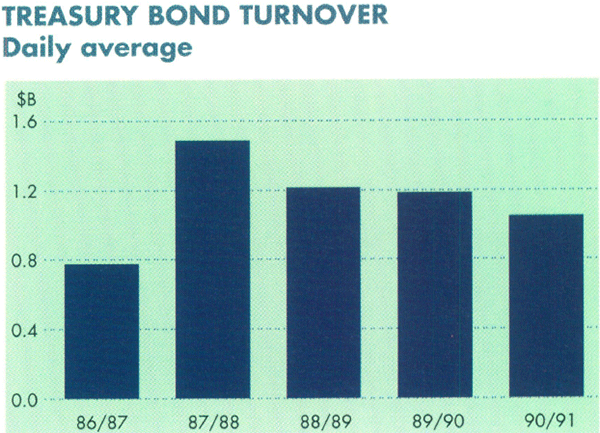
Other Securities Markets
In addition to the slow growth in credit noted earlier, direct financing by the private sector through securities issues was also subdued in 1990/91. Equity issues totalled $6.6 billion, 26 per cent less than in the previous year. One-third of these reflected reinvestment of dividends, i.e. shareholders reinvesting dividend payments in exchange for shares rather than taking the dividends as cash.
Secondary market activity on the share market was also subdued, as it has been since the share market tumbled in October 1987; the value of share transactions averaged about $220 million a day. Share prices in Australia were little changed over the year as a whole, with the effects of lower interest rates offset by the recession. Prices declined in the first half year but recovered strongly in the second half; this was broadly in line with trends in overseas markets.
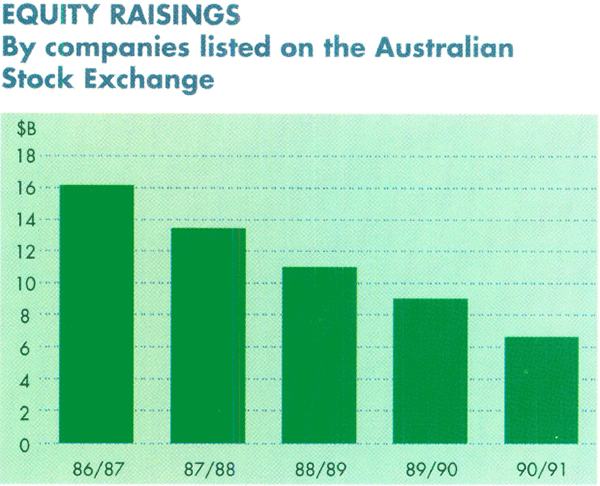
Longer-term private fixed-interest issues amounted to $5.6 billion in 1990/91, a little higher than in the previous year. At year end, stock on issue totalled $15.1 billion. More than half the issues last year were by banks which raised $3.4 billion or about 20 per cent of their total domestic fund raisings in this market.
Issues backed by securitised assets – mainly mortgages – totalled $2.1 billion in 1990/91, increasing the stock on issue to $5.5 billion. These securities allow lenders to move assets off their balance sheets by repackaging them into more marketable securities which are then onsold. This releases funds for new lending. A large part of the mortgage-backed issues in 1990/91 was associated with State Government housing schemes.
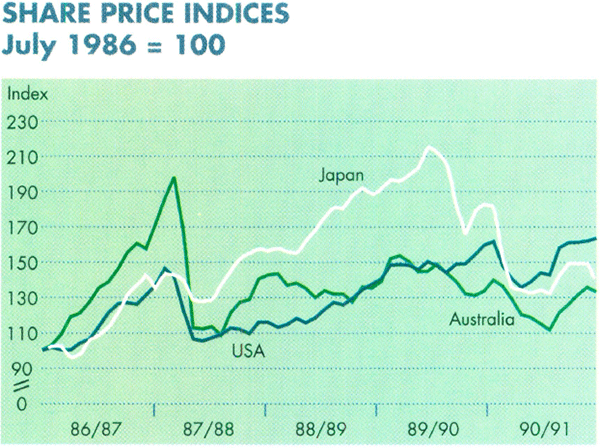
Financing through issues of promissory notes grew moderately in 1990/91, with amounts on issue rising by $2.2 billion to $16 billion. This market is used by private borrowers with strong credit ratings who are able to bypass intermediaries and raise short-term funds in their own names. Public authorities are also active in this market.
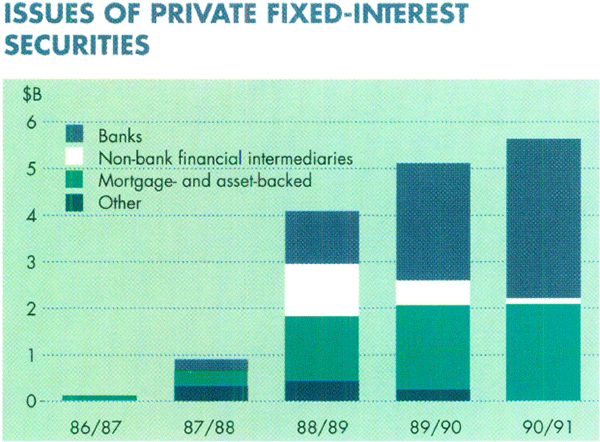
As noted earlier, State Governments were required to borrow in their own names in 1990/91 to fund maturities of Commonwealth Government securities which previously had been issued on their behalf. This change, together with the general deterioration in their budget positions caused in part by the recession, made for sizeable issues of State debt during the year. The amount outstanding in the actively traded “hot stocks” rose by almost $10 billion to $45 billion. Turnover in these securities continued to grow strongly and, despite an increase in outstandings relative to Commonwealth bonds, there were further falls over the year in yield margins for some State Government securities vis-a-vis Commonwealth bonds.
Oversight of the Foreign Exchange Market
Under the Banking (Foreign Exchange) Regulations, dealers in foreign exchange in Australia require authorisation by the Reserve Bank. During the year, the number of authorised dealers declined from 81 to 77, comprising 32 banks and 45 non-banks. The decline in numbers reflected the withdrawal from the market by some non-bank dealers in response to heightened competitive pressure and the rationalisation by some groups of their world-wide activities. This trend towards rationalisation was apparent also in other countries and reflects, in part, the introduction of the Basle guidelines for capital adequacy, which have encouraged banks to be more critical in their allocation of capital resources among various activities.
The Bank consults with authorised foreign exchange dealers about their activities in the market and on aspects of their internal systems for controlling foreign exchange exposures. It also convenes a Foreign Exchange Market Consultative Group, which provides a forum for members of the dealing and broking communities to discuss market developments and relevant issues. A prominent issue recently has concerned arrangements to allow the netting of foreign exchange transactions among dealers. Netting arrangements can take many forms, such as bilateral arrangements between dealers to convert their gross liabilities to each other to one net position, or more ambitious arrangements to allow multilateral netting among a group of dealers (and even cross-border netting involving participants in other countries). Netting is intended to allow more efficient settlement of transactions, and to help reduce firms' exposures to each other, thereby reducing potential claims on capital. Five Australian banks have begun a trial of bilateral netting arrangements; these are informal and cover four currencies, including the Australian dollar.
In August 1990 the Bank, acting on behalf of the Commonwealth, imposed wide-ranging sanctions against Iraq and Kuwait under the Banking (Foreign Exchange) Regulations. This gave effect to the United Nations Security Council resolution which was adopted following Iraq's invasion of Kuwait. The sanctions prohibited the buying and selling of foreign currency, as well as a range of other financial transactions with the Government of Iraq or Kuwait, their agencies or their nationals. The measures imposed in relation to Kuwait were repealed in April 1991.
The Treasurer announced in April 1991 that restrictions on borrowings in Australia by foreign governments, their agencies and international institutions had been lifted. This was one of the few controls retained in 1983 when other exchange controls were removed. Foreign official entities may now borrow in the Australian capital market, provided they comply with domestic laws and regulations and submit to Australian jurisdiction. Borrowers are required to notify the Bank or the Commonwealth Treasury of their raisings in Australia and, where amounts over $100 million are involved, to consult with either the Bank or Treasury prior to the raising.
Authorised Money Market Dealers
The authorised money market dealers are a specialist group of market traders with whom the Bank conducts the bulk of its domestic market operations. Apart from being the prime counterparties for the Bank in its market operations, the dealers make markets in short-term Commonwealth Government paper and provide a facility for the investment of short-term funds at minimal risk. The commercial banks' working balances comprise the bulk of the dealers' liabilities and the Bank's trading with dealers is largely designed to offset influences on these balances which originate elsewhere in the system.
Two new dealers commenced operations in 1990/91, namely Rothschild Australia Discount Limited and Schroders Australia Discount Limited, the only new firms to be accredited since the establishment of the market in 1959/60 (although most other firms had undergone ownership changes since then). The entry of the new dealers followed changes to the guidelines in 1989/90 which removed the requirement for a spread of ownership and the restriction on foreign ownership. They brought the number of dealers to ten but this was subsequently reduced to eight with the acquisition of BNY Discount Limited by Short Term Holdings Limited, and the decision by NDC Securities Limited to cease operations.
Trading, Clearing and Settlement Systems
With the increasing globalisation of financial markets, countries require world-class systems and procedures in their securities markets if they are to remain competitive in the provision of financial services. A report on clearing and settlement arrangements, issued in 1989 by a number of concerned market participants known as the Group of Thirty (G30), provided standards against which these systems are likely to be judged. Australia fell some way below these standards, especially in the equities market, and the Bank has been involved, along with market participants and regulators, in seeking to make the necessary improvements. To this end the following steps were taken.
- The Reserve Bank's electronic transfer and settlement system for Commonwealth Government securities (RITS), developed in conjunction with Austraclear, commenced operations on 6 August 1991. This new system allows Treasury notes and bonds to be transferred and settled simultaneously on a trade-for-trade basis through computer entries. The system is broadly similar to that provided by Austraclear for other discount and coupon securities: the principal difference is that settlement, based on payment obligations undertaken by members' banks, is irrevocable.
- In October 1990, the Australian Stock Exchange completed the move to computerised screen trading for all listed stocks. Improvements were made to the equity settlement and clearance system, with the inclusion of a greater number of the more heavily traded stocks in the FAST (Flexible Accelerated Securities Transfer) clearance procedures. Development work also continued on a new electronic clearing system, CHESS (Clearing House Electronic Sub-register System). This will feature electronic transfers through a central clearing house, delivery versus payment, and shorter closed-period settlement; it is expected to bring equities settlement up to Group of Thirty standards. The Bank is a member of the Steering Committee established under the auspices of the Australian Securities Commission to achieve that goal.